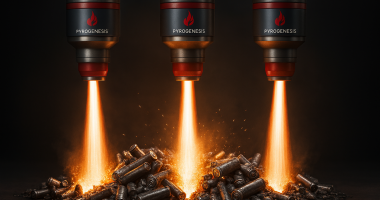How well do you know your clinical patients? What if there was a way to uncover the hidden relationship between patients in clinical trials empowering scientists to make critical decisions. Lyndsay Malchuk from Stockhouse Publishing recently sat down with NetraMark Holdings Inc. (CSE:AIAI and OTCQB:AINMF), CEO, George Achilleos to talk about how the company decodes the complexities of patient populations and offers invaluable insights to clinical trial professionals.
The following is a transcription of the above video, and The Market Online has edited it for clarity.
Lyndsay: Let’s dive right in. You are a seasoned BE with over 25 years of experience that began in the tech sector at IBM. Now, I know you’ve been involved in many different tech businesses. What drew you to NetraMark?
George: Well thanks for reminding me how long I’ve been around. I appreciate that. It’s been a long time, and these gray hairs have been earned, that’s for sure. I’ve been involved in the technology industry for a long time, and there’s always a few key nuggets that I look for before I get involved in any company. And the facts are the facts, which you really have to start with is, is there a clear problem? I mean, that’s the number one thing we always are looking for as a business. And if you look at the clinical trial space in the pharmaceutical industry, trials fail at 90% from molecule inception through to commercialization. That’s a ridiculous number.
And if you look at late phases, so you know a trial goes through phase one, phase two, phase three, et cetera. If you look at phase two going into phase three, phase three trials fail at between 50% and 65% depending on the therapeutic area. And that’s the worst place to fail. Because you’ve spent all this money and you’re spending probably the largest amount in phase three. So, that’s a terrible place to fail. So, I always start with, is there a real obvious problem that a guy like me can understand and clinical trials fail at a ridiculous rate. I paired that with, wow, there appears to be a great solution that’s actually a paradigm shift that could address this problem. That’s what drew me to NetraMark.
Lyndsay: Well, that’s quite a story and we all know that in any company you look for the pain point that’s going to bridge that gap between you and anything else. We know also that there are a lot of movements happening within the AI space right now, especially in the healthcare industry. What differentiates NetraMark from the crowd?
George: If I look at AI in the pharmaceutical industry, I like to put it into buckets. I like to simplify everything for myself. And when I look at those buckets, AI, the place that it likes to lend itself first is large data sets. You hear this, you know, AI loves data. So, within the AI space, where are the obvious places to point at? Well, let’s start with drug discovery because there are these massive data sets that AI can have access to, to help discover new drugs. So, I want to be clear, we don’t do that. That’s a very crowded space, as you said, and hundreds of millions of dollars are being spent there. And I really hope one day, you know, seven to 10 years from now, we’ll see the first AI discovered drug hit market. So that’s one bucket.
The other bucket is in clinical operations. So now you’ve got a trial that’s actually ongoing and you have to run the trial. You’ve got to recruit patients. Well, that’s another place to point AI. Why? Because you can get access to large data sets, electronic medical records that I can ingest and help find those patients faster so I can recruit them faster. That’s all great, great places to point AI. What this points itself at, what really differentiates it is the small data sets that are in the clinical trial. So, 65% of trials have less than a hundred patients and 90% have less than a thousand patients. Those aren’t large data sets. So, AI doesn’t naturally go there. But Dr. Joseph Geraci, who is the PhD mathematician who founded the technology, spent almost seven years wondering about this and working on the mathematical formulas to say, Hmm, in a clinical trial when you get to the end of a phase, you get what’s called a clinical trial data readout. Data about that drug that was administered to the patients in that trial, small data sets.
And he was wondering, could I figure out a mathematical way to ingest those small data sets and find statistically relevant subpopulations that affect three things in particular, drug response, placebo response, and adverse events, things that could cause, you know, horrible things to happen. It was a very difficult problem to solve. That’s why AI doesn’t point itself there. It’s the problem that Dr. Geraci solved. And what differentiates us is we can ingest these small data sets. We can then look at thousands and thousands of variables associated with every patient that was collected, and we can find the hidden subpopulations that could be causing a clinical trial to potentially fail. So that when you go to design, you come out of phase two, and you go to design what’s called a protocol for the next phase of the trial in there is what’s called a study population. We can now enrich the inclusion exclusion criteria. Who should we include and who should we exclude based on the subpopulations that Dr. Geraci found that affect drug response, placebo response and adverse events. And there’s not many companies that can do this due to the small subpopulations.
Lyndsay: What you’ve done is look at your smallest viable market and you ran with that. NetraMark, as mentioned, is a company that uncovers the hidden relationship between patients in clinical trials. Can other companies do this as well though?
George: No, when I get on a call with a banking groups, analysts that are covering other companies, my question always is have you run across any other companies that can do this? Because if you do, I would like to know. There are companies that are taking different approaches to solving clinical trial failure rates, such as digital twin technology, et cetera. But in particular, the way that we’re doing it, which is to use mathematics to find the small subpopulations that could be affecting a trial, the answer is no.
And traditional statistical methods and AI often overfits, it tries to put populations into this group and this group. What we do is we call it the good, the bad, and the ugly. We try to find the good, the people that are the drug responders and don’t respond to placebo, the bad, the people that don’t respond to the drug and respond to placebo. And then we have another group called the Ugly. So as opposed to overfitting, our machine says, you know, we don’t really know much about this group. We’re going to put them over there to not cause hallucinations and pollute these other two groups so that we can find those subpopulations that are potentially causing clinical trial failures.
Lyndsay: The most important part of building any company to do just what you’re doing is having the right team in place. Can you speak to the key management team members that are now in and part of your management team?
George: So, great question. I am, as I said, a technology guy. I’m not a pharmaceutical industry person. So, as you can imagine, penetrating the pharmaceutical industry from a sales perspective is very, very difficult. And the only way you can really grant yourself access in the early stages is through people. So, the first thing I did when I became CEO was to very rapidly work on recruiting people. So, the first hire was Josh Spiegel. He was the former head of commercialization and business development at a company called VeraSci, which was in the clinical trial space. Then it was sold to WCG for $330 million US. He joined as our President to help commercialize.
Our Chief Regulatory Officer is Dr. Luca Pani, former director general of the Italian Medicines Agency, where he managed a multi-billion dollar budget, oversaw about 800 drugs go into market, works closely now with the European Medicines Agency and now resides in Washington. That’s our Chief Regulatory Officer.
Our Chief Medical Officer is the former executive director at Pfizer, head of therapeutics at Johnson and Johnson and director at Novartis.
And we just announced Dr. Angelico Carta as our Chief Strategy Officer. He was the co-founder and president of Worldwide Clinical Trials. So, in the world of clinical trials, often what’s called a contract research organization, a CRO, in 75% of the cases runs the trial. Well Worldwide operates in over 65 countries around the world. He was the co-founder and president of that organization. It was recently bought by Kohlberg & Company. So, this is a very, very, very large CRO. He joined as our Chief Strategy Officer.
So, it’s all great to have a problem. You’ve got to have great technology, but you’ve got to have a really, really amazing management team to commercialize and succeed. And I feel very, very grateful to have the people around me that I do to help make NetraMark a reality.
Lyndsay: You’ve built the community that is unstoppable. Help us understand, what are you all focused on accomplishing this year then?
George: Well, I often say this, and it sounds like a broken record. Validation, validation, validation. What does that mean? Well, when you have a new technology and it’s AI, which is all this mysterious AI stuff and you’re introducing it to an industry that’s got a regulator hovering over top, the number one question is, how do I know this thing works? So, the only way to do that is to validate it through publications and posters, et cetera. To give you an example on that side of how we validate we’ve announced a collaboration agreement with the NIMH, which is one of the 27 institutes of the NIH, the largest biological research institution in the world. We’re working on four of their studies. We’ve announced a collaboration agreement with a top five, by market cap, global pharmaceutical company. Unfortunately, I can’t name the name, but top five, you can put two and two together.
That’s pretty big. So, we’re working on these kinds of collaborations so that we can co-publish the findings so that we can show the market what we’re able to do. That’s number one. And on the other side, it’s validation through contracts. Do pharmaceutical companies actually pay you money to use your technology?
So, we’re fortunate to have landed our beachhead client. It’s a $10 billion plus biopharmaceutical company listed on the NASDAQ, it’s got over 15 drugs in their portfolio. We started with one contract, we’ve expanded to four, we’re now bidding on more. And so that to me is validation through contracts, product market fit as people like to say it. And we’ve started with one and we’ve expanded, which I think would tell the audience, I think this technology actually works. And I think in their words they’ve said, this changes how we view clinical trials moving forward. So, I think it’s all about validation. Our technology is priced for penetration with these pharmaceutical companies right now, so we can get validation and that’s going to be our focus over the next 12 months.
Lyndsay: You’re definitely trailblazing. We all know that everything in AI right now is very promising technology. How much does it cost to run the business and how do you get the company to be cashflow positive then?
George: Well, that’s a great question because obviously we’re in the AI business, we’re a technology business, and people assume, wow, you guys have to be burning millions of dollars to run and build this technology. So, what I can tell your audience is, and if you look at our MD&A, which has the adjusted EBITDA, which is important because we have a lot of non-cash items. If you were to look at our fixed cash burn, it’s about $160,000 Canadian per month. So, I would ask your audience members to find another AI company that has a little less than a $2 million annual fixed cash burn. Our gross margin profile. If you look at our financials, there’s no cost of goods sold, but I’ll just say it’s 90% plus just because I have to. So, if you look at that and you think about it, every dollar of revenue is going to cover SG&A, which means at a little over $2 million we can be cashflow positive or EBITDA positive. And so, our goal at the back end of 2025 is to begin having EBITDA positive orders, which is really, really anomalous for an AI company that’s targeting the pharmaceutical industry.
Lyndsay: What next then? What can investors expect in the coming quarters?
George: Most importantly? Obviously, I talked about collaborations and contracts. Those were the main things that we can expect in the coming quarters. And also, conferences. We will be presenting posters and validation documents, et cetera. And also, partnership agreements. We’re really focused on creating some channel partners which are global in nature to help us accelerate our footprint. And I think that is what will fuel our business moving forward.
You can find NetraMark Holdings Inc. on CSE under the ticker symbol AIAI and they also trade on the OTCQB market under AINMF. To learn more, check out their website at netramark.com
Company shares last traded at $1.52
Join the discussion: Find out what everybody’s saying about this stock on the NetraMark Holdings investor discussion forum, and check out the rest of Stockhouse’s stock forums and message boards.
The material provided in this article is for information only and should not be treated as investment advice. For full disclaimer information, please click here.



